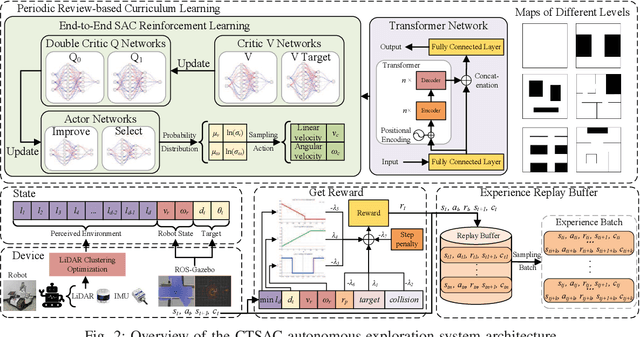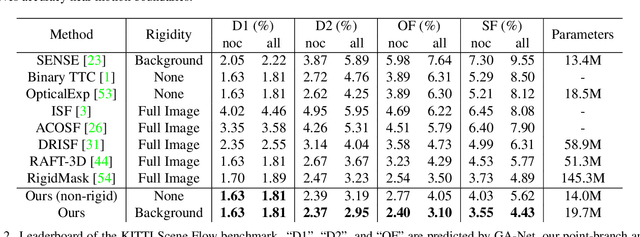Yihui Xu
CTSAC: Curriculum-Based Transformer Soft Actor-Critic for Goal-Oriented Robot Exploration
Mar 18, 2025



Abstract:With the increasing demand for efficient and flexible robotic exploration solutions, Reinforcement Learning (RL) is becoming a promising approach in the field of autonomous robotic exploration. However, current RL-based exploration algorithms often face limited environmental reasoning capabilities, slow convergence rates, and substantial challenges in Sim-To-Real (S2R) transfer. To address these issues, we propose a Curriculum Learning-based Transformer Reinforcement Learning Algorithm (CTSAC) aimed at improving both exploration efficiency and transfer performance. To enhance the robot's reasoning ability, a Transformer is integrated into the perception network of the Soft Actor-Critic (SAC) framework, leveraging historical information to improve the farsightedness of the strategy. A periodic review-based curriculum learning is proposed, which enhances training efficiency while mitigating catastrophic forgetting during curriculum transitions. Training is conducted on the ROS-Gazebo continuous robotic simulation platform, with LiDAR clustering optimization to further reduce the S2R gap. Experimental results demonstrate the CTSAC algorithm outperforms the state-of-the-art non-learning and learning-based algorithms in terms of success rate and success rate-weighted exploration time. Moreover, real-world experiments validate the strong S2R transfer capabilities of CTSAC.
Learning Optical Flow and Scene Flow with Bidirectional Camera-LiDAR Fusion
Mar 21, 2023Abstract:In this paper, we study the problem of jointly estimating the optical flow and scene flow from synchronized 2D and 3D data. Previous methods either employ a complex pipeline that splits the joint task into independent stages, or fuse 2D and 3D information in an ``early-fusion'' or ``late-fusion'' manner. Such one-size-fits-all approaches suffer from a dilemma of failing to fully utilize the characteristic of each modality or to maximize the inter-modality complementarity. To address the problem, we propose a novel end-to-end framework, which consists of 2D and 3D branches with multiple bidirectional fusion connections between them in specific layers. Different from previous work, we apply a point-based 3D branch to extract the LiDAR features, as it preserves the geometric structure of point clouds. To fuse dense image features and sparse point features, we propose a learnable operator named bidirectional camera-LiDAR fusion module (Bi-CLFM). We instantiate two types of the bidirectional fusion pipeline, one based on the pyramidal coarse-to-fine architecture (dubbed CamLiPWC), and the other one based on the recurrent all-pairs field transforms (dubbed CamLiRAFT). On FlyingThings3D, both CamLiPWC and CamLiRAFT surpass all existing methods and achieve up to a 47.9\% reduction in 3D end-point-error from the best published result. Our best-performing model, CamLiRAFT, achieves an error of 4.26\% on the KITTI Scene Flow benchmark, ranking 1st among all submissions with much fewer parameters. Besides, our methods have strong generalization performance and the ability to handle non-rigid motion. Code is available at https://github.com/MCG-NJU/CamLiFlow.
CamLiFlow: Bidirectional Camera-LiDAR Fusion for Joint Optical Flow and Scene Flow Estimation
Nov 20, 2021



Abstract:In this paper, we study the problem of jointly estimating the optical flow and scene flow from synchronized 2D and 3D data. Previous methods either employ a complex pipeline which splits the joint task into independent stages, or fuse 2D and 3D information in an ``early-fusion'' or ``late-fusion'' manner. Such one-size-fits-all approaches suffer from a dilemma of failing to fully utilize the characteristic of each modality or to maximize the inter-modality complementarity. To address the problem, we propose a novel end-to-end framework, called CamLiFlow. It consists of 2D and 3D branches with multiple bidirectional connections between them in specific layers. Different from previous work, we apply a point-based 3D branch to better extract the geometric features and design a symmetric learnable operator to fuse dense image features and sparse point features. We also propose a transformation for point clouds to solve the non-linear issue of 3D-2D projection. Experiments show that CamLiFlow achieves better performance with fewer parameters. Our method ranks 1st on the KITTI Scene Flow benchmark, outperforming the previous art with 1/7 parameters. Code will be made available.
 Add to Chrome
Add to Chrome Add to Firefox
Add to Firefox Add to Edge
Add to Edge